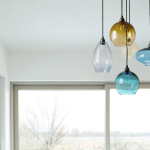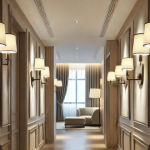
Pendant lamps have been around for centuries, with their origins dating back to ancient civilizations. However, in recent years, modern pendant lamps have experienced a surge in popularity. These sleek and stylish lighting fixtures have become a staple in contemporary interior design, adding both functionality and aesthetic appeal to any space.
The history of pendant lamps can be traced back to the use of oil lamps in ancient times. These lamps were suspended from the ceiling using chains or ropes, providing a source of light that could be easily moved around the room. Over time, pendant lamps evolved and became more sophisticated, incorporating different materials and designs.
In today’s design world, modern pendant lamps have become highly sought after for their clean lines and minimalist aesthetic. They are often used as statement pieces, adding a touch of elegance and sophistication to any room. Whether used in kitchens, dining areas, living rooms, or bedrooms, modern pendant lamps have become a popular choice for homeowners and interior designers alike.
The Beauty of Simple Design: Minimalist Pendant Lamps
One of the key characteristics of modern pendant lamps is their minimalist design. Minimalism is a design philosophy that emphasizes simplicity and functionality. It focuses on clean lines, neutral colors, and the use of natural materials. Minimalist pendant lamps embody these principles, making them a perfect choice for those who appreciate understated elegance.
Minimalist pendant lamps often feature simple geometric shapes such as spheres, cylinders, or cones. They are typically made from materials such as glass, metal, or wood, with clean finishes that enhance their sleek appearance. These lamps are designed to blend seamlessly into any space without overpowering the overall aesthetic.
Examples of minimalist pendant lamps include the iconic PH Artichoke Lamp by Poul Henningsen and the Nelson Saucer Pendant Lamp by George Nelson. These lamps showcase the beauty of simplicity and are highly versatile, making them suitable for a wide range of interior styles.
Minimalist pendant lamps can enhance a space by providing a focal point without overwhelming the room. Their clean lines and neutral colors create a sense of calm and serenity, making them ideal for creating a peaceful atmosphere in bedrooms or meditation spaces. In open-concept living areas, minimalist pendant lamps can define different zones and add visual interest without cluttering the space.
The Art of Crafting: Handmade Pendant Lamps
In a world dominated by mass-produced items, there is a growing appreciation for handmade products. Handmade pendant lamps offer a unique charm and character that cannot be replicated by machines. They are crafted with care and attention to detail, resulting in one-of-a-kind pieces that add a personal touch to any space.
Artisanal techniques are often used in the making of handmade pendant lamps. These techniques can include hand-blown glass, hand-forged metalwork, or hand-carved wood. Each piece is meticulously crafted by skilled artisans who take pride in their workmanship.
One of the appeals of handmade pendant lamps is the ability to customize them to suit your individual style and preferences. Many artisans offer customization options such as choosing the color, finish, or size of the lamp. This allows you to create a truly unique piece that reflects your personality and complements your existing decor.
Handmade pendant lamps come in a variety of designs, from traditional to contemporary. They can add warmth and character to any space, whether it’s a rustic farmhouse kitchen or a modern industrial loft. These lamps are not just functional lighting fixtures; they are works of art that can elevate the overall design of a room.
The Power of Color: Vibrant Pendant Lamps
Color plays a crucial role in interior design, as it has the power to evoke emotions and set the mood in a space. Vibrant pendant lamps are an excellent way to incorporate color into your decor and make a bold statement.
Colorful pendant lamps come in a wide range of hues, from soft pastels to vibrant jewel tones. They can be made from various materials such as glass, ceramic, or fabric, allowing for endless possibilities in terms of color and texture.
When choosing a colorful pendant lamp, it’s important to consider the overall color scheme of the room. You can opt for a lamp that complements the existing colors or choose one that contrasts for a more dramatic effect. For example, a blue pendant lamp can add a pop of color to a neutral-toned room, while a red pendant lamp can create a focal point in an otherwise monochromatic space.
Incorporating color into your decor with pendant lamps doesn’t have to be limited to the lamp itself. You can also play with color by using colored bulbs or adding colored filters to the lampshade. This allows you to change the ambiance of the room with just a flick of a switch.
Lighting Up Your Space: The Functionality of Pendant Lamps
One of the reasons why pendant lamps have become so popular is their versatility and functionality. They can be used in various ways to improve the lighting in a room and create different atmospheres.
Pendant lamps come in different types, including task lighting, ambient lighting, and accent lighting. Task lighting pendant lamps are designed to provide focused illumination for specific activities such as reading or cooking. They are often used in kitchens, home offices, or study areas.
Ambient lighting pendant lamps are used to create a general illumination in a room. They provide overall brightness and can be used as the primary source of light in living rooms, dining areas, or bedrooms.
Accent lighting pendant lamps are used to highlight specific areas or objects in a room. They add depth and visual interest by creating shadows and highlighting architectural features or artwork.
The versatility of pendant lamps is further enhanced by their adjustability. Many pendant lamps come with adjustable cords or rods, allowing you to change the height and position of the lamp to suit your needs. This makes them ideal for spaces with high ceilings or for creating layered lighting effects.
The Magic of Materials: Pendant Lamps Made from Unconventional Materials

Pendant lamps are not limited to traditional materials such as glass or metal. In recent years, designers have been experimenting with unconventional materials to create unique and eye-catching pendant lamps.
Examples of unconventional materials used in pendant lamps include concrete, paper, fabric, and even recycled materials such as plastic bottles or old books. These materials add texture and interest to a space, making the pendant lamp a focal point in the room.
Concrete pendant lamps, for example, have a raw and industrial look that can add a touch of urban chic to any space. They are often used in modern or minimalist interiors and can be paired with other concrete elements such as countertops or flooring for a cohesive design.
Paper pendant lamps, on the other hand, have a delicate and ethereal quality that can create a soft and romantic ambiance. They are often used in bedrooms or dining areas to add a touch of elegance and femininity.
When incorporating pendant lamps made from unconventional materials into your decor, it’s important to consider the overall style of the room. These lamps can be statement pieces on their own, so it’s best to keep the rest of the decor simple and let the lamp take center stage.
Size Matters: Choosing the Right Pendant Lamp for Your Space
Choosing the right size pendant lamp is crucial to ensure that it fits proportionally in your space and provides adequate lighting. There are several factors to consider when determining the size of a pendant lamp.
Firstly, you need to consider the size of the room. In larger rooms, you can opt for larger pendant lamps that make a bold statement. In smaller rooms, it’s best to choose smaller pendant lamps that don’t overwhelm the space.
Secondly, you need to consider the height of the ceiling. For rooms with high ceilings, you can choose pendant lamps with longer cords or rods to create a dramatic effect. For rooms with low ceilings, it’s best to choose pendant lamps with shorter cords or rods to avoid a cramped feeling.
Lastly, you need to consider the purpose of the pendant lamp. If you’re using it as task lighting, such as in a kitchen or home office, you’ll need a pendant lamp that provides focused illumination. In this case, it’s best to choose a pendant lamp that is closer to eye level and doesn’t hang too low.
When in doubt, it’s always a good idea to consult with a professional interior designer who can help you choose the right size pendant lamp for your space.
The Perfect Pair: Combining Pendant Lamps with Other Lighting Fixtures
Pendant lamps can be used on their own as statement pieces, but they can also be combined with other lighting fixtures to create a cohesive lighting design in your space.
One way to combine pendant lamps with other lighting fixtures is by using them in conjunction with recessed lighting. Recessed lighting provides overall illumination in a room, while pendant lamps add visual interest and serve as focal points. This combination creates a layered lighting effect that adds depth and dimension to the space.
Another way to combine pendant lamps with other lighting fixtures is by using them in pairs or groups. This works particularly well in dining areas or kitchen islands, where multiple pendant lamps can be hung at different heights for a dramatic effect. This not only provides ample lighting but also creates a sense of balance and symmetry in the room.
When combining pendant lamps with other lighting fixtures, it’s important to consider the overall style and design of the room. The different fixtures should complement each other and create a cohesive look. It’s also important to consider the scale and proportion of the fixtures to ensure that they fit harmoniously in the space.
Lighting the Way: Pendant Lamps as Statement Pieces
Pendant lamps have the power to serve as statement pieces in a room, adding a touch of drama and personality. They can be used to create a focal point or to highlight specific areas or objects.
One way to use pendant lamps as statement pieces is by choosing bold and eye-catching designs. These can include oversized pendant lamps, pendant lamps with intricate patterns or textures, or pendant lamps with vibrant colors. These lamps instantly draw attention and become the center of attention in the room.
Another way to use pendant lamps as statement pieces is by using them in unexpected ways. For example, instead of hanging a pendant lamp over a dining table, you can hang it over a coffee table or a seating area to create a cozy and intimate atmosphere. This unexpected placement adds an element of surprise and creates a unique design feature.
When using pendant lamps as statement pieces, it’s important to consider the overall design of the room. The lamp should complement the existing decor and enhance the overall aesthetic. It’s also important to consider the scale and proportion of the lamp to ensure that it doesn’t overpower the space.
The Timeless Appeal of Modern Pendant Lamps
In conclusion, modern pendant lamps have become increasingly popular in recent years due to their sleek design, functionality, and versatility. Whether you prefer minimalist designs, handmade craftsmanship, vibrant colors, unconventional materials, or statement-making pieces, there is a pendant lamp out there that will suit your style and enhance your space.
Pendant lamps have come a long way since their humble beginnings as oil lamps suspended from the ceiling. Today, they are considered works of art that can transform any room into a stylish and inviting space. With their timeless appeal and ability to add both style and function, modern pendant lamps are here to stay. So why not consider adding one to your home and see the difference it can make?






